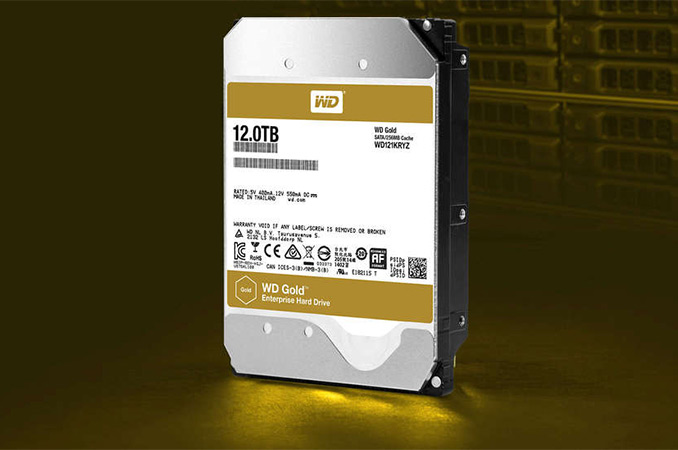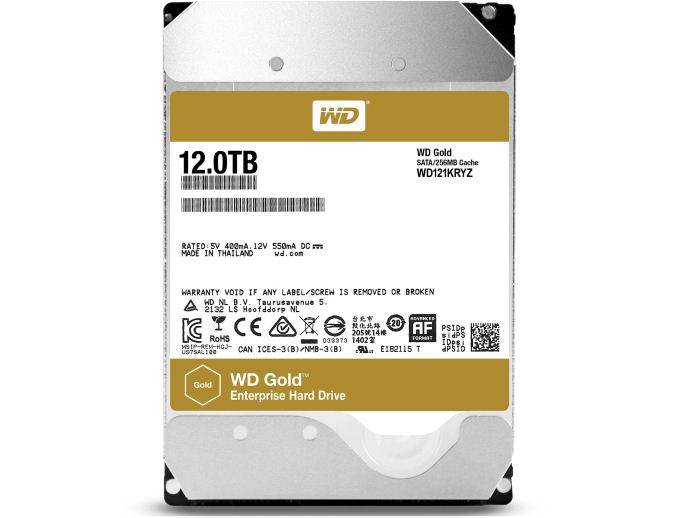Western Digital Ships 12 TB WD Gold HDD: 8 Platters and Helium
by Anton Shilov on September 16, 2017 9:00 AM EST- Posted in
- HDDs
- Storage
- WD
- Western Digital
- Helium HDD
- WD Gold

Western Digital has begun to ship its WD Gold HDD with 12 TB capacity to partners and large retailers. The 3.5” drive relies on the same platform as the HGST Ultrastar He12 launched this year, and will initially be available to select customers of the company. The WD Gold 12 TB is designed for enterprise workloads and has all the performance and reliability enhancements that we come to expect, but the availability at retail should make them accessible to wider audiences.
From a hardware point of view, the WD Gold 12 TB is similar to the HGST Ultrastar He12 12 TB hard drive: both are based on the fourth-generation HelioSeal technology that uses eight perpendicular magnetic recording platters with a 1.5 TB capacity for each platter. The internal architecture of both HDDs was redesigned compared to predecessors to accommodate the eighth platter. Since the WD Gold and the Ultrastar He12 are aimed at nearline enterprise environments, they are equipped with various sensors and technologies to protect themselves against vibration and as a result, guarantee sustained performance. For example, the WD Gold and the Ultrastar He12 attach their spindles both to the top and the bottom of the drives. In addition the HDDs feature a special technology that increases the accuracy of head positioning in high-vibration environments to improve performance, integrity, and reliability. Finally, both product families support TLER (time-limited error recovery) rebuild assist mode to speed up RAID recovery time.
Since the WD Gold 12 TB and the HGST Ultrastar He12 are similar internally and feature the same 7200 RPM spindle speed, they also have similar performance — the manufacturer puts them both at 255 MB/s sustained transfer rate and 4.16 ms average latency. The main difference between the WD Gold and the HGST Ultrastar He12 are the enterprise options for the latter: there are models with the SAS 12 Gb/s interface and there are models with SED support and Instant Secure Erase feature.
| Comparison of Western Digital's WD Gold HDDs | ||||||||
| WD121KRYZ | WD101KRYZ | WD8002FRYZ | WD6002FRYZ | WD4002FRYZ | ||||
| Capacity | 12 TB | 10 TB | 8 TB | 6 TB | 4 TB | |||
| RPM | 7200 RPM | |||||||
| Interface | SATA 6 Gbps | |||||||
| DRAM Cache | 256 MB | 128 MB | ||||||
| NAND Cache | Unknown | No | Yes | Unknown | ||||
| Helium-Filling | Yes | No | ||||||
| Data Transfer Rate (host to/from drive) | 255 MB/s | 249 MB/s | 205 MB/s | 226 MB/s | 201 MB/s | |||
| MTBF | 2.5 million | |||||||
| Rated Annual Workload | 550 TB | |||||||
| Acoustics (Seek) | - | 36 dBA | ||||||
| Power Consumption | Sequential read | 7 W | 7.1 W | 7.2 W | 9.3 W | 9 W | ||
| Sequential write | 6.8 W | 6.7 W | 7 W | 8.9 W | 8.7 W | |||
| Random read/write | 6.9 W | 6.8 W | 7.4 W | 9.1 W | 8.8 W | |||
| Idle | 5 W | 5.1 W | 7.1 W | 7 W | ||||
| Warranty | 5 Years | |||||||
| Price as of September 9, 2017 | MSRP | $521.99 | $410.99 | $327.99 | $244.99 | $183.99 | ||
| Per GB | $0.0435 | $0.0411 | $0.041 | $0.0408 | $0.046 | |||
| GB per $ | 22.98 GB | 24.33 GB | 24.39 GB | 24.48 GB | 21.73 GB | |||
Western Digital aims its WD Gold and HGST Ultrastar He-series drives at operators of cloud and exascale data centers that demand maximum capacity. The 12 TB HDDs can increase the total storage capacity for a single rack from 2440 TB to 2880 TB, replacing 10 TB drives with 12 TB drives, which can be a major benefit for companies that need to maximize their storage capacity per watt and per square meter. Where the HGST-branded drives are made available primarily through B2B channels, the WD Gold are sold both through B2B and B2C channels and thus can be purchased by wider audiences. For example, boutique PC makers, as well as DIY enthusiasts, may start using the WD Gold 12 TB for their high-end builds, something they could not do with the HGST drives. These HDDs may be considered as an overkill for desktops, but since WD’s desktop offerings top at 6 TB, the WD Gold (and the perhaps inevitable future WD Red Pro 12 TB) is the WD’s closest rival for Seagate’s BarraCuda Pro drives.
The WD Gold HDD is currently available directly from Western Digital for $521.99 as well as from multiple retailers, including Newegg for $539.99. While over $500 for a hard drive is expensive, it is actually less than Western Digital charged for its WD Gold 8 TB about 1.5 years ago ($595) and considerably less than the initial price of the WD Gold 10 TB drive last April.
Related Reading:
- Western Digital: Sales of Helium-Filled HDDs Accelerating, 15M Sold So Far
- Western Digital Starts Shipments of HGST Ultrastar He12 12 TB HDDs
- Western Digital Expands Purple Lineup with a 10 TB Helium-Filled HDD
- Western Digital Announces Ultrastar He12 12 TB and 14 TB HDDs
- Western Digital Adds Helium-Filled WD Gold 10 TB HDD to Lineup
Source: Western Digital











62 Comments
View All Comments
damianrobertjones - Sunday, September 17, 2017 - link
I bet if they'd annoinced 16Tb you'd have asked for 20.versesuvius - Saturday, September 16, 2017 - link
36 TB, anybody?Risk - Saturday, September 16, 2017 - link
Yes, please. Higher density works just fine for this consumer "enthusiast".MrSpadge - Saturday, September 16, 2017 - link
Of all the meaningless arbitrarily high numbers, why did you choose 36? Isn't 42 much nicer?Slaveguy - Saturday, September 16, 2017 - link
I have a 12' long chain that I use to crack lips and teeth that belong to trash just like youLordSojar - Sunday, September 17, 2017 - link
I think you're on the wrong site.... the BDSM site is this way ----->MajGenRelativity - Tuesday, September 19, 2017 - link
What?ltcommanderdata - Saturday, September 16, 2017 - link
"For example, boutique PC makers, as well as DIY enthusiasts, may start using the WD Gold 12 TB for their high-end builds, something they could not do with the HGST drives. These HDDs may be considered as an overkill for desktops, but since WD’s desktop offerings top at 6 TB, the WD Gold (and the perhaps inevitable future WD Red Pro 12 TB) is the WD’s closest rival for Seagate’s BarraCuda Pro drives."So is there any concern with using TLER HDDs on non-RAID desktops in terms of data integrity? With TLER and without RAID is data corruption more likely since the drive no longer tries to recover from errors as aggressively? I've read there's no longer any way to disable TLER on newer WD NAS HDDs.
ddriver - Saturday, September 16, 2017 - link
HGST HE10 are perfectly acceptable. Hardware raid is a bad idea. ZFS FTW. Putting mechanical storage in a workstation - bad idea. Dedicated build, ECC, a good HBA, a fast and durable SSD for cache. And you are set for several years, HGST drives are very reliable if you buy from someone who handles shipments with care. I never ever order HDDs online and wait for shipment to my door, I go straight to the warehouse of the primary importer and buy from there.extide - Saturday, September 16, 2017 - link
Another vote for ZFS here. For anyone still on the fence about SW RAID, think about it, most RAID cards have 3-400Mhz PowerPC chips on them from 90's vintage, any modern multi-core multi Ghz cpu is going to be able to calculate parity sums significantly faster. Plus then your array isn't tied to specific HW, for example if your RAID card dies, you need to find another that will recognise your array, whereas with SW RAID it will work in just about any system. All they need to add to ZFS is the ability to expand an existing VDEV in-place, or have it redistribute data evenly across an array if you add VDEVs..